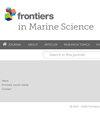“保育湾和隐藏的鳐鱼”:对马耳他群岛内牛鳐(aeetomylaeus bovinus)长期监测的首次见解
IF 3
2区 生物学
Q1 MARINE & FRESHWATER BIOLOGY
引用次数: 0
摘要
本研究构成了马耳他群岛(MA,地中海中部)内牛aeomylaeus分布和人口统计学的一种新的定量评估。根据世界自然保护联盟的红色名录,牛甲杆菌在全球和地中海地区都处于极度濒危状态。因此,全面了解其生态属性和行为是采取适当保护措施的必要条件。尽管它们在提供生态系统服务方面发挥着至关重要的作用,但关于MA周围蝙蝠类的信息仍然有限,这引起了人们对其数量日益减少和灭绝风险的担忧。在长达14年的研究(2011-2024)中,马耳他鲨鱼实验室的成员与“与牛鳐一起飞”(FWBR)项目一起收集了照片识别数据,以确定当地牛甲的地点保真度、种群结构和时空行为模式。季节模式和相对丰度也被确定。在MA附近共进行了859次调查,共发现牛虻407次,鉴定出135只个体。在最初的观察中,大约44.8%的个体至少重新看到了一次,多个个体在长时间内表现出很高的重新看到率,表明了站点的保真度。马耳他西北部、东北部和东部的某些关键地区代表了MA中牛伊马杆菌的最大丰度。种群以年轻个体为主,由盘宽定义,97.7%的目击由一年中的年轻个体到亚成年个体组成。这些数据,连同地点保真度,这些关键区域较高的幼鱼丰度,以及在14年的研究期间这些区域的持续使用表明,MA区域支持a .牛的托儿所功能。高旅游压力、不受管制的捕捞和气候变化等人为压力因素可能会影响关键地区,因此需要采取有针对性的保护措施。本文章由计算机程序翻译,如有差异,请以英文原文为准。
“Nursery bays and hidden rays”: First insights into long-term monitoring of Bull Rays (Aetomylaeus bovinus) within the Maltese Archipelago
This study constitutes a novel quantitative assessment of Aetomylaeus bovinus distribution and demographics within the Maltese archipelago (MA, Central Mediterranean). According to the IUCN red list, A. bovinus is critically endangered, both globally and in the Mediterranean. Therefore, a comprehensive understanding of its ecological attributes and behaviors is necessary for adequate conservation measures. Despite their crucial role in providing ecosystem services, information on batoids around the MA remains limited, raising concerns over their increasing population decline and extinction risk. During this fourteen-year-long study (2011-2024), photo-identification data were collected by members of Sharklab-Malta in conjunction with the Fly With Bull Rays (FWBR) program in order to identify site fidelity, population structure and temporal-spatial behavioral patterns of local A. bovinus . Seasonal patterns and relative abundance were also ascertained. A total of 859 surveys were conducted around the MA, with a total of 407 sightings of A. bovinus and the identification of 135 individuals. Approximately 44.8% of identified individuals were re-sighted at least once following initial observations, with multiple individuals showing high re-sighting rates across lengthy temporal periods and indicating site fidelity. Certain key areas in the NW, NE and E of Malta represent the greatest abundance of A. bovinus in the MA. The population is dominated by younger individuals, defined by disc width, with 97.7% of sightings consisting of young of the year to sub-adults. These data, in tandem with site fidelity, higher abundances of juveniles in these key areas and consistent use of these areas over the fourteen-year study period suggest that areas of the MA support a nursery function for A. bovinus . Anthropogenic stressors such as high touristic pressure, unregulated fishing and climate change are likely to impact key areas, posing a need for targeted conservation measures.
求助全文
通过发布文献求助,成功后即可免费获取论文全文。
去求助
来源期刊

Frontiers in Marine Science
Agricultural and Biological Sciences-Aquatic Science
CiteScore
5.10
自引率
16.20%
发文量
2443
审稿时长
14 weeks
期刊介绍:
Frontiers in Marine Science publishes rigorously peer-reviewed research that advances our understanding of all aspects of the environment, biology, ecosystem functioning and human interactions with the oceans. Field Chief Editor Carlos M. Duarte at King Abdullah University of Science and Technology Thuwal is supported by an outstanding Editorial Board of international researchers. This multidisciplinary open-access journal is at the forefront of disseminating and communicating scientific knowledge and impactful discoveries to researchers, academics, policy makers and the public worldwide.
With the human population predicted to reach 9 billion people by 2050, it is clear that traditional land resources will not suffice to meet the demand for food or energy, required to support high-quality livelihoods. As a result, the oceans are emerging as a source of untapped assets, with new innovative industries, such as aquaculture, marine biotechnology, marine energy and deep-sea mining growing rapidly under a new era characterized by rapid growth of a blue, ocean-based economy. The sustainability of the blue economy is closely dependent on our knowledge about how to mitigate the impacts of the multiple pressures on the ocean ecosystem associated with the increased scale and diversification of industry operations in the ocean and global human pressures on the environment. Therefore, Frontiers in Marine Science particularly welcomes the communication of research outcomes addressing ocean-based solutions for the emerging challenges, including improved forecasting and observational capacities, understanding biodiversity and ecosystem problems, locally and globally, effective management strategies to maintain ocean health, and an improved capacity to sustainably derive resources from the oceans.
 求助内容:
求助内容: 应助结果提醒方式:
应助结果提醒方式:


